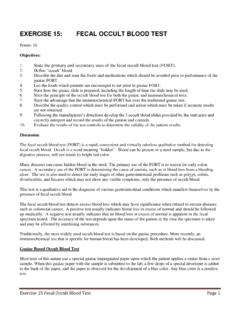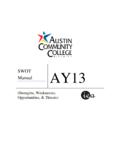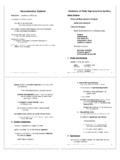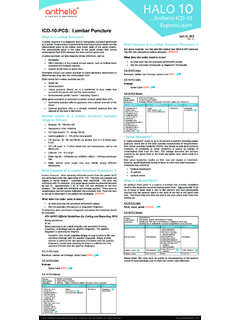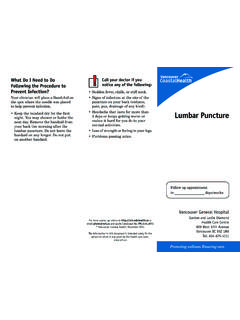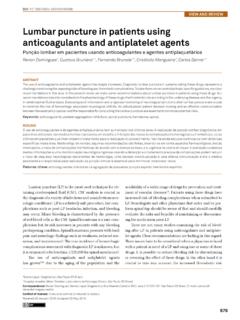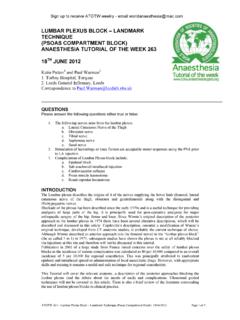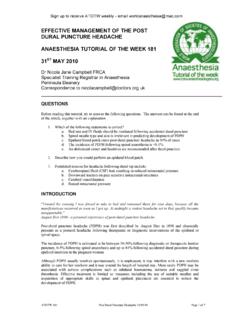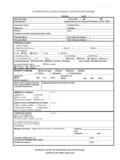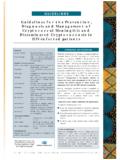Transcription of LABORATORY 8: Body Fluid Cell Count
1 LABORATORY 8: body Fluid Cell Count Points Points are awarded for Admission Tickets. Points are also awarded for general lab skills, neatness, lab clean-up, and teamwork as well as successful and timely completion of study questions. Student results are expected to be within 20% of instructor's values. Study questions are due by the end of the next lab period or as designated by the lab instructor. Overview This lab is a review of selected body fluids, how they are collected and the manual cell counting procedure. Students are expected to review and apply objectives provided in the related lecture units. Objectives Using the criteria stated in the body Fluid cell counts and body Fluid differential LABORATORY exercises, in accordance with standards set by the instructor, the student will be able to: 1. Correctly classify color and transparency 2. Perform WBC and RBC cell counts on two body Fluid specimens within 20% accuracy using the hemacytometer.
2 3. After making necessary calculations, use appropriate recording format to report results. 4. Use quality control results to determine the acceptability of test results. 5. Answer all pre-test and study questions using related information found in the textbook, lecture guide, and this lab procedure and submit the results to the instructor by the due date. Equipment and Supplies 1. Two body Fluid specimens 2. Capillary pipets, and Kimwipes 3. Hemacytometer with coverslip 4. Lens cleaner, lens paper, and alcohol prep pads 5. Microscope 6. Cell Counter 7. Petri dish with cover and dampened cotton ball Supplemental References Current hematology course textbook MLAB 1311 course Lecture and Lab Guides and course textbook(s). Web resources: Wikipedia The Free Encyclopedia. (Collins, Leilani, Examination of body fluids: evaluating gross appearance; performing cell counts. On-line article, American Society for Clinical LABORATORY Science, Wintr 2009, Volume: 22, Source Issue 1).
3 The Free Education Network YouTube: Loading a hemacytometer correctly YouTube: Counting cells 1. MLAB 1311 UA/BF LABORATORY Exercise 8. Revised 9/21/2015. Principles & Related Information According to Wikipedia, a hemacytometer is a thick glass microscope slide with a laser-etched grid of perpendicular lines. The device is carefully crafted so that the area bounded by the lines is known, and the depth of the chamber is also known. It is therefore possible to Count the number of cells or particles in a specific volume of Fluid , and thereby calculate the concentration of cells in the Fluid overall.. The typical Neubauer-type hemacytometer consists of two identical ruled counting areas composed of laser- etched lines that define squares of specific dimensions. When a coverglass of specified uniform thickness is positioned over the ruled areas of the hemacytometer, a chamber with a depth of is created.
4 By counting the cells /particles within a specified part of the grid, it is possible to calculate the number of cells /particles in a volume of the Fluid . To the left is a drawing representative of how the entire ruled / grid area of one of the hemacytometer chambers would appear under the microscope. The total dimension of the grid area is 3mm X 3mm. There are nine (9) larger squares contained within the grid; each of which measures 1 mm x 1mm. Although their internal appearance varies, each of these 9 larger squares has a total volume of mm3. The volume of a large square = mm3. The large square in the middle of the hemacytometer grid has been subdivided into twenty five (25) smaller squares. Each of these smaller squares has a volume of The volume of a small square = mm3. body Fluid specimens (other than urine) are collected by way of a minor surgical procedure. Fluid Collection procedure cerebral spinal Fluid (CSF) Spinal tap / lumbar puncture (needle inserted between the 3rd and 4th OR 4th and 5th lumbar vertebra).
5 Plural Fluid Thoracentesis (needle aspiration of Fluid in lung cavity). pericardial Fluid Paracardiocentesis (needle aspiration of Fluid surrounding the heart). synovial Fluid Artherocentesis (needle aspiration of joint Fluid ). In a normal person, the volumes of these fluids (with the exception of CSF) are too low to be easily obtained. It is only in conditions of disease or trauma would there be justifiable reason and volume for collection and testing. The exact number and types of body Fluid specimen tubes drawn depends on: the Fluid type and volume, the reason for the procedure, and the test procedures being ordered. body Fluid testing must be performed ASAP, as the deterioration of specimen components occurs quickly. The appearance of body fluids can provide valuable diagnostic information about a patient's condition. Both color and clarity must be recorded on the report form. An abnormal color or clarity in a body Fluid can provide clues to suspected conditions or disease.
6 A milky appearance may indicate involvement by the lymphatic system; reddish coloring often indicates the presence of blood, and a cloudy thick purulent Fluid is often the result of microorganisms and WBCs. White and red blood cell counts provide important information for the diagnosis and treatment of diseases involving CSF, serous, and synovial cavities. Under normal circumstances, these fluids have very low counts. Increased numbers of cells can be seen as the result of trauma or a disease process. To summarize, body fluids normally contain very few blood cells , are expected to be sterile and are obtained and analyzed following a trauma or when infections, hemorrhages, and malignancies are suspected. 2. MLAB 1311 UA/BF LABORATORY Exercise 8. Revised 9/21/2015. Cerebral spinal Fluid (CSF). CSF is a clear colorless Fluid produced by the choroid plexus of the brain at a rate of approximately 20 mL/hr in the adult patient.
7 The Fluid flows through the subarachnoid space where it serves to cushion, protect and nourish the brain cortex before being re-absorbed by the arachnoid villus at about the same rate as its production. CSF is NOT considered to be an ultra-filtrate of blood. The CSF specimen is collected by lumbar puncture between the 3rd & 4th or 4th and 5th lumbar vertebrae and placed in three sterile tubes; labeled 1, 2, and 3 in the order in which they are drawn. Tube 1 is used for chemical and serological tests. Tube 2 is used for microbiological tests. Tube 3 is used for cell counts and differentials. (If a 4th tube is drawn, Tube 1 may not be used.). The analysis of cerebral spinal Fluid (CSF) provides physicians a means of evaluating the central nervous system. Spinal tap and CSF analysis is performed on patients suspected of having meningitis and encephalitis (due to bacterial, viral, fungal or parasitic organisms); neurosyphilis, degenerative nerve diseases such as multiple sclerosis and Guillain-Barre syndrome, subarachnoid hemorrhages and metastatic tumors including leukemias.
8 The CSF is normally colorless and clear in appearance. Yellow, pink or orange are abnormal colors. If the sample remains an abnormal color after centrifugation, the appropriate term to describe the specimen is xanthrochromic. Refer to the lecture materials for more information on xanthochromia. The normal CSF WBC Count is 0-5 / uL in an adult patient (0-3/uL newborns) while the RBC Count = 0/uL. Serous fluids Serous fluids are the small amounts of fluids within closed cavities of the body . They primarily function to provide lubrication between the organs and the tissues lining the body cavity. Serous fluids are ultra filtrates of plasma and are most often pale yellow to yellow in color and clear. They are normally produced and reabsorbed at constant and balanced rate. An imbalance in the production/ reabsorption results in an effusion or increased volume. An effusion resulting from a systemic problem would likely be classified as a transudate'.
9 And one resulting from a local inflammatory response would be an exudate'. Serous fluids are usually collected in sterile tubes and sent to the LABORATORY for microbiology culture, cell counts & differential, cytology, and chemical testing. In some cases, the serous Fluid may be sent to the LABORATORY in the syringe in which it was drawn. The serous fluids commonly discussed are the plural Fluid - from the lung cavity, the pericardial Fluid that surrounds the heart and the peritoneal Fluid (also called ascites) which is found in the abdominal cavity. Synovial Fluid , from the joint cavities, is also an ultrafiltrate of plasma, but contains hyaluronate which makes it much more viscous than plasma. Normally pale yellow and clear, but may have some slight cloudiness due to the presence of synovial cell debris and fibrin. The body Fluid Cell Count Traditionally body Fluid white and red blood cells have been done by manual methods using a hemacytometer counting chamber.
10 The average number of cells (individually) counted on both sides of the chamber is placed into a formula that calculates the number of cells per unit of volume. The basic formula to calculate manual cell counts: # cells /uL. Notes: 1. Since the body fluids do not normally contain many cells , they rarely need to be diluted prior to plating on the hemacytometer. When the specimen is NOT diluted, the Dilution Factor (the number that is put in the calculation formula stated above) is 1". On the rare occasions when a dilution is required, normal saline is the diluent of choice, and appropriate dilution factor must be included in the formula for calculating the results. See listed references for additional directions on use of the hemacytometer and performance of cell counts. 2. The number of squares and which squares to be counted generally depends on how many cells are present. If there are very few cells present, counting the cells seen in the entire 9 large square grid will produce the more accurate results.


